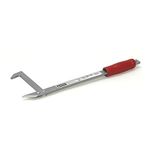Podcast Episode 662: Roof Venting, Roof Leaks, and High-Performance Framing
Listeners write in about haunted pipes and building-science tomes, and they ask questions about roof venting and roof leaks.

Welcome to the Fine Homebuilding podcast, our weekly discussion of building, remodeling, and design topics aimed at anybody who cares deeply about the craft and science of working on houses. This is senior editor Patrick McCombe. I’m joined by Fine Homebuilding editorial director Brian Pontolilo, Fine Homebuilding technical editor Mark Petersen, and producer Andres Samaniego. Please email us your questions to fhbpodcast@finehomebuilding.com.
You can find previous podcasts and check out the show notes at finehomebuilding.com/podcast
 |
Check in:
Mark: New shop

Patrick: Trip to Orange Beach, Ala.
RELATED STORIES:
Listener Feedback 1:
John writes:
Greetings all,
Regarding the tub filler discussion in episode #655, I once noticed the same phenomenon in a tub I used. The water volume coming from the showerhead was greatest when the temperature selector was centered between hot and cold. My theory is that the tub-filler assembly could only accommodate a certain volume/pressure of water. When the flow is fully opened to both hot and cold pipes, the filler assembly, with its “blocker,” restricts the flow such that the excess volume of water starts to rise in the vertical pipe leading to the showerhead, and eventually spills out the showerhead. You can prove this concept by partially covering the filler outlet with your hand and waiting a moment to see water begin trickling out of the showerhead. I used to do this as a kid. Just be warned, it’s hard to do without spraying water everywhere.
I hope this makes sense. Thanks for all the good work,
John
RELATED STORIES:
Listener Feedback 2:
Chris writes:
Hey Patrick.
I’ve received my well-used copy of Dr. William Shurcliff’s Superinsulated Houses book. I have found it an extremely fun read so far—in part because of what hasn’t changed, in part because of some things that have changed so drastically. (Also, it’s awesome to see the evidence of just how much it has been read!)
One thing I wanted to throw out to you immediately (before my book report is submitted) was that I’ve since learned Dr. Shurcliff died in 2006 from pneumonia. Here is his obituary:
While there is no mention in that obituary regarding his work in the realm of building science, it is clear in just the opening pages of this book that building science was a passion for him. In light of there being no mention of it in his official remembrances, I think it is wonderful that his work on building envelopes, insulation, and home energy use/conservation were highlighted by Fine Homebuilding nearly two decades after his passing. Some may consider that “keeping craft alive.”
Cheers,
Christopher
RELATED STORIES:
Question 1: How do we vent the roof of an addition?
Ryan writes:
Hi FHB podcast crew,
I’m in the middle of building a large addition onto my house. I’ve been in the trades (mostly millwork and fine carpentry) for almost two decades now, but this is my first time as a GC on a major job. I thought that being around the other trades for so long would at least give me a leg up in doing so… Boy was I wrong, but that’s another story.
I’m writing in because I have a question about cathedral ceilings and closed-cell foam. I’m near Seattle, so it’s very rainy this time of the year with some medium-sized storms. My main house is from 1941 and will receive an inline intake vent and a ridge vent. In order to line up the floors of the addition to the main house floors, my architect vaulted the bedroom and bathroom ceilings to give enough head room. According to him, in order to meet code in relation to 2×8 rafters, we need to spray closed-cell spray foam Are there any other options?
The issue is that part of the addition will be attached and at the same height as the main house. My roofer thought it would look nice to continue the ridge vent across the addition as well. They wouldn’t cut out the roof like normal for a vent, but it would still leave an opening for air and moisture to come in. He thought maybe spraying closed-cell foam on top of the ridge beam would seal the gap above it.
My question is two parts:
- Would having an opening above the ridge beam, albeit a sealed opening, with closed-cell foam be okay? (I’m worried about moisture.) If not, how would you handle the roof ridge where the addition meets the main house? Are we destined to have part of the roof ridge line with part ridge vent and part not?
- In my research, I’m seeing some recommendations for using vapor venting instead of ridge vents. While it seems like it’s not required in my climate zone ( I think we are 4C), my wife is a bit worried after reading The Guardian’s article about the rot and mold issues of those homeowners who used closed-cell spray foam. I’m guessing most of those issues were a building assembly issue, not about spray foam in general, but does closed-cell foam require a vapor vent or, better yet, should we use a vapor vent for the cathedral ceilings? I was required to have a continuous running 140-cfm bathroom fan that also has a built-in humidity meter. Maybe that would be enough to keep moisture down?
I would appreciate any insight you have on this issue. I’ve attached photos of the addition and plans to help show what I mean.
PS – Maybe after I get my roof on and I can stop waking up at 4 AM to hearing drips of water coming into the laundry room, getting on the roof to fix the tarps after the wind shreds them, or just all the headaches of doing a lot of the work myself, I could send a few tips I have learned along the way. 😂
Thanks again for your time,
Ryan
RELATED STORIES
Question 2: Is it okay or normal to build a new roof for an addition over the existing?
Joseph writes:
Hello folks!
You guys are awesome, and I’ve been a listener for years now as well as a magazine subscriber.
This leak is beyond something I wanna tackle. In the video, you’ll notice the old roof and a few layers of shingles along with the old rafters. I guess you’ll figure it out from the video. I’m a little upset now, so that’s all I can say.
I’m hoping you guys can give me some nice words to tell the company who installed the new/8-year-old roof, which is kinda on top of the old roof. I apologize, but I can’t seem to get the words out correctly for this email. I’m a little tired and frustrated with my old house. I’m guessing if I knew what I know now after listening to you guys, I would’ve looked at my wife and said, “On to next house!”
 |
 |
 |
RELATED STORIES
Dan Kolbert’s new FHB E-learning course on framing.
Unfortunately that is all the time we have for today. Thanks to Mark, Brian, and Andres for joining me and thanks to all of you for listening. Remember to send us your questions and suggestions to fhbpodcast@finehomebuilding.com and please like, comment, or review us no matter how you’re listening–it helps other folks find our podcast.
Happy Building!
Fine Homebuilding Recommended Products
Fine Homebuilding receives a commission for items purchased through links on this site, including Amazon Associates and other affiliate advertising programs.

QuikDrive PRO300s

Guardian Fall Protection Pee Vee

Sledge Hammer




























